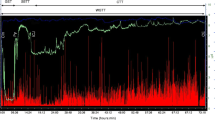Abstract
To investigate the pathophysiology of faecal incontinence in diabetes mellitus, two groups of diabetic patients were studied: 14 subjects (7 females and 7 males, mean age 57±9 years) with faecal incontinence (Group A) and 15 subjects (6 females and 9 males, mean age 54.7±8 years) without faecal incontinence but affected by somatic peripheral neuropathy. A third group (C) of 10 healthy volunteers was used as controls. All subjects underwent electroneurographic evaluation of peripheral neuropathy, pudendal nerve terminal motor latency, anorectal manometry and rectal sensitivity tests. All the patients of group A had somatic peripheral neuropathy. Maximum squeeze pressure was lower in A compared to C (P<0.025) and sustained for a shorter period in A compared with B (P<0.0005) and C (P<0.0005). All rectal sensitivity thresholds were higher in A compared with B and C. Pudendal Nerve Terminal Motor Latency was prolonged in 93% of patients studied in group A and in 73% of patients in group B (A vs BP<0.005), with a significant difference in comparison with C: A vs CP<0.0005, B vs CP<0.005. Our findings suggest that somatic neuropathy plays an important role in faecal incontinence in diabetic patients, combined with sesation threshold impairment as a feature of an autonomic involvement.
Résumé
Afin d'étudier la pathophysiologie de l'incontinence fécale en cas de diabète, deux groupes de patients diabétiques ont été analysés: 14 sujets incontinents (7 femmes et 7 hommes dont l'âge moyen est de 57±9 ans) (groupe A) et 15 sujets sans incontinence mais porteurs d'une neuropathie périphérique (6 femmes et 9 hommes dont l'âge moyen est de 54,7±8 ans). Un troisième groupe (groupe C) constitué de 10 volontaires sains a servi de groupe contrôle. Tous les sujets ont subi des investigations électroneurographiques de leur neuropathie périphérique, une mesure du temps de latence du nerf honteux interne, une manométrie anorectale et des tests de sensibilité rectale. Tous les patients du groupe A présentent une neuropathie somatique périphérique. La pression maximale de rétention est plus basse dans le groupe A que dans le groupe C (P<0,025) et peut être maintenue moins longtemps dans le groupe A que dans le groupe B (P<0,0005) ou que dans le groupe C (P<0,0005). Les seuils de sensibilité rectale sont plus élevés dans le groupe A que dans les groupes B et C. Le temps de latence du nerf honteux interne est allongé chez 92,9% des patients étudiés dans le groupe A et 73,3% des patients du groupe B (A vs B,P<0,005); la différence est encore plus significative en comparaison avec le groupe C (A vs CP<0,0005, B vs CP<0,005). Nos constations suggèrent que la neuropathie somatique joue un rôle important dans la genèse de l'incontinence chez les patients diabétiques, en combinaison avec des altérations du seuil de sensibilité rectale en tant que symptôme d'une atteinte autonome.
Similar content being viewed by others
References
Horowitz M (1988) Disorders of the gastrointestinal motility associated with diabetes mellitus. Motility 4:4–9
Yang R, Arem R, Chan L (1984) Gastrointestinal tract complications of diabetes mellitus. Pathophysiology and management. Arch Int Med 144:1251–1256
Feldman M, Schiller LR (1983) Disorders of gastrointestinal motility associated with diabetes mellitus. Ann Intern Med 98:378–384
Kassander P (1958) Asymptomatic gastric retention in diabetics (gastroparesis diabeticorum). Ann Intern Med 48:797–812
Mollis JB, Castell DO, Braddom RL (1977) Esophageal function in diabetes mellitus and its relation to peripheral neuropathy. Gastroenterology 73:1098–1102
Goyal RK, Spiro HM (1971) Gastrointestinal manifestations of diabetes mellitus. Med Clin North Am 55:1031–1044
Ewing DJ, Clarke BF (1986) Diabetic autonomic neuropathy: present insights and future prospects. Diabetes Care 9:648–665
Vinik A, Mitchell B (1988) Clinical aspects of diabetic neuropathies. Diabetes Metab Rev 4:223–252
Rundles RW (1945) Diabetic neuropathy: general review with report of 125 cases. Medicine 24:111–160
Barges JA, Bollman JL, Kepler EJ (1936) The diarrhoea of diabetes and steatorrhea of pancreatic insufficiency. Proc Staff Meeting Mayo Clin 11:737–742
Martin MM (1958) Diabetic neuropathy: a clinical study of 150 cases. Brain 76:594–624
Lejeune D, Melange M, Daumerie Ch, Buysschaert M, Vanheuverzwijn R (1986) Interêt comparé de la manometrie anorectale et de l'electrocardiographie dans le diagnostic de la neuropathie autonome diabetique. Gastroenterol Clin Biol 10:554–557
Schiller LR, Santa Ana CA, Schulen C et al (1982) Pathogenesis of fecal incontinence in diabetes mellitus: evidence for internal anal sphincter dysfunction. N Eng J Med 307:1666–1671
Aitchison M, Fisher BM, Carter K, McKee R, McCuish AC, Finlay IG (1991) Impaired anal sensation and early diabetic faecal incontinence. Diabet Med 8:960–963
Wald A, Tunuguntla AK (1984) Anorectal sensimotor dysfunction in fecal incontinence and diabetes mellitus. N Engl J Med 310:1282–1287
Rogers J, Levy DM, Henry MM, Misiewicz JJ (1988) Pelvic floor neuropathy: a comparative study of diabetes mellitus and idiopathic fecal incontinence. Gut 29:756–761
Kiff ES, Swash M (1984) Slowed conduction in the pudendal nerve in idiopathic (neurogenic) fecal incontinence. Br J Surg 71:614–616
Rogers J, Henry MM, Misiewicz JJ (1988) Combined sensory and motor deficit in primary neuropathic faecal incontinence. Gut 29:5–9
Erckembert JF, Winter HJ, Cicmir I, Wienbeck M (1988) Faecal incontinence in diabetes mellitus: Is it correlated to diabetic autonomic or peripheral neuropathy? Z Gastroenterol 26:731–736
Consensus statement: report and recommendation of the S. Antonio Conference on Diabetic Neuropathy. Diabetes (1988) 37:1000–1005
Crepaldi G, Fedele D, Tiengo A et al (1983) Ganglioside treatment in diabetic peripheral neuropathy: a multicenter trial. Acta Diabet Lat 20:265–276
Caruana BJ, Wald A, Hinds JP, Eidelman BH (1991) Anorectal sensory and motor function in neurogenic function in neurogenic fecal incontinence. Gastroenterology 100:465–470
Jones PN, Lubowsky DZ, Swash M, Henry M (1987) Relation between perineal descent nerve damage in idiopathic faecal incontinence. Int J Colorect Dis 2:93–95
Snooks SJ, Swash M, Mathers SE, Henry M (1990) Effect of vaginal delivery on the pelvic floor: a 5 years follow up. Br J Surg 77:1358–1360
Author information
Authors and Affiliations
Rights and permissions
About this article
Cite this article
Pintor, M.P., Zara, G.P., Falletto, E. et al. Pudendal neuropathy in diabetic patients with faecal incontinence. Int J Colorect Dis 9, 105–109 (1994). https://doi.org/10.1007/BF00699423
Accepted:
Issue Date:
DOI: https://doi.org/10.1007/BF00699423




